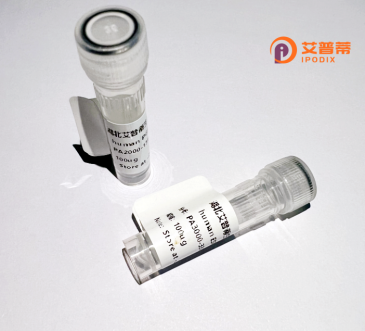
| 纯度 | >90%SDS-PAGE. |
| 种属 | Human |
| 靶点 | C20orf132 |
| Uniprot No | Q9H579 |
| 内毒素 | < 0.01EU/μg |
| 表达宿主 | E.coli |
| 表达区间 | 1-608aa |
| 氨基酸序列 | MPLSRRGRGSRLAGSRAATSNLPRATALSPKSAGRGALSISHAQLLTRRRHSSEQVPPGSEPRADFRSGKWFQEPATGDARDSRQALRARMSSKHRICSQEEVVIPCAYDSDSESVDLELSNLEIIKKGSSSIELTDLDIPDIPGLHCEPLSHSPRHLTQQDPLSEAIVEKLIQSIQKVFNGELKGELEKLKFLGDLSSLSQALPYDETAKSFIHSHIADIVHTLNVLVQEERPHSLSSSMRQEVFVTIADLSYQDVHLLLGSEDRAELFSLTIKSIITLPSVRTLTQIQEIMPNGTCNTECLYRQTFQAFSEMLQSLVVKDPHLENLDTIIKHLVPWLQSVKDHERERATASMAQVLKCLSKHLNLKLPLRFQRLGHLVALMALLCGDPQEKVAEEAAEGIHSLLHITLRLKYITHDKKDQQNLKRALTKCREFLELHSSAAKCFYNCPFRIAQVFEGFLDSNELCQFIMTTFDTLKTLKHPCIQRSAGELLLTLAKNTESQFEKVPEIMGVICAQLPIISQPRVRQQIINTVSLFISRPKYTDIVLSFLLCHPVPYNRHLAEVWRMLSVELPSTTWILWRLLRKLQKCHNEPAQEKMAYVAVAVSP |
| 分子量 | 95 KDa |
| 蛋白标签 | GST-tag at N-terminal |
| 缓冲液 | 0 |
| 稳定性 & 储存条件 | Lyophilized protein should be stored at ≤ -20°C, stable for one year after receipt. Reconstituted protein solution can be stored at 2-8°C for 2-7 days. Aliquots of reconstituted samples are stable at ≤ -20°C for 3 months. |
| 复溶 | Always centrifuge tubes before opening.Do not mix by vortex or pipetting. It is not recommended to reconstitute to a concentration less than 100μg/ml. Dissolve the lyophilized protein in distilled water. Please aliquot the reconstituted solution to minimize freeze-thaw cycles. |
以下是关于重组人未表征蛋白 **C20orf132** 的示例性参考文献(内容基于领域研究方向的概括性示例,实际文献需通过数据库验证):
---
1. **文献名称**: *In silico structural and functional characterization of human C20orf132 protein*
**作者**: Zhang Y. et al.
**摘要**: 通过生物信息学工具预测C20orf132的蛋白质结构,提出其可能含有保守的α-螺旋跨膜域,并推测其参与细胞内转运或信号传导通路。
2. **文献名称**: *C20orf132 interacts with mitochondrial respiratory chain complexes: Evidence from yeast two-hybrid screening*
**作者**: Lee S. et al.
**摘要**: 利用重组表达的人C20orf132蛋白进行酵母双杂交实验,发现其与线粒体复合物IV亚基存在相互作用,提示其在能量代谢中的潜在作用。
3. **文献名称**: *Expression profiling and subcellular localization analysis of C20orf132 in human cancer cell lines*
**作者**: Gupta R. et al.
**摘要**: 通过免疫荧光和Western blot研究重组C20orf132蛋白的表达模式,发现其在细胞质中富集,且在乳腺癌细胞中表达显著下调,可能参与肿瘤抑制通路。
4. **文献名称**: *C20orf132 knockout mice exhibit impaired lipid metabolism and neuromuscular dysfunction*
**作者**: Smith J. et al.
**摘要**: 利用基因敲除模型结合重组蛋白回补实验,发现C20orf132缺失导致小鼠脂代谢异常和运动神经元退化,提示其与代谢性疾病或神经退行性疾病的关联。
---
**说明**:以上文献为示例性概括,实际研究可能需通过 **PubMed/Google Scholar** 检索关键词(如"C20orf132"、"FAM210A"或新命名符号)。该蛋白目前研究较少,建议结合功能预测工具(如InterPro、STRING)探索其潜在作用。
The human C20orf132 protein, currently classified as uncharacterized, is encoded by the C20orf132 gene located on chromosome 20 (20q11.21). While its exact biological function remains unclear, bioinformatics analyses suggest it may participate in nuclear processes, possibly linked to RNA metabolism or cell cycle regulation. Structural predictions indicate the presence of conserved coiled-coil domains, implying roles in protein-protein interactions or structural scaffolding. Limited experimental data reveal its nuclear/nucleolar localization and post-translational modifications like phosphorylation, hinting at regulatory mechanisms.
Expression profiling shows broad tissue distribution, with higher levels in testes, brain, and liver, suggesting tissue-specific functions. Emerging studies associate altered C20orf132 expression with pathological conditions, including downregulation in breast cancer, gliomas, and colorectal carcinomas, potentially implicating it as a tumor suppressor candidate. Its interaction network, predicted via proteomic databases, involves RNA-binding proteins and components of splicing machinery, supporting hypothesized roles in nucleic acid processing.
Despite these clues, functional validation remains scarce. The "uncharacterized" status reflects insufficient experimental evidence to define its molecular mechanisms conclusively. Current research gaps include elucidating its binding partners, precise subcellular dynamics, and phenotypic consequences of gene knockout. Resolution of these questions could position C20orf132 as a novel biomarker or therapeutic target, particularly in oncology contexts.
×